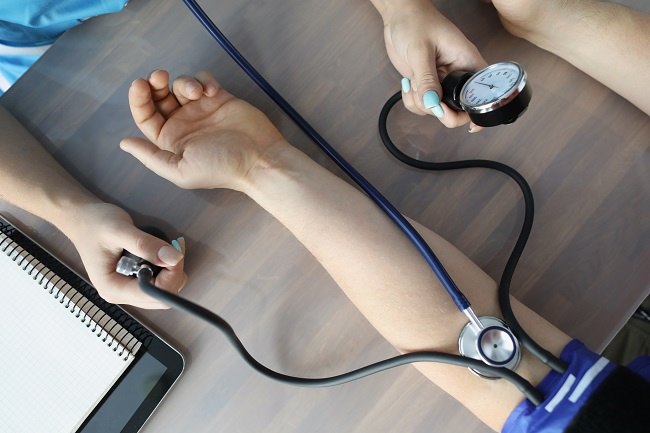Hypertension is a non-communicable disease that still requires attention and gives significant health risks. Hypertension or high blood pressure is defined as a condition where systolic value is more than 140 mmHg and diastolic more than 90 mmHg on two times measurement with the range of about five minutes and relaxed condition. The aforementioned blood pressure was permanent, leading to disturbance of nutrients and oxygen intake, which should be not clogged and transferred normally to the required body’s tissues. The health profile of East Java Province in 2018 showed that the prevalence of hypertension in Surabaya was 31.13%, it is lower than the previous year, which was 45.32%. However, promotive and preventive medicine is still needed because it is higher than the national prevalence.
Worldwide target aims to reduce the prevalence of hypertension as many as 25% by 2025. Common symptoms that appear in patients are dizziness, nosebleeds, frequent headaches, and shortness of breath. Two types of hypertension were identified—those are secondary hypertension which means a systemic, increasing blood pressure which cause still can’t be detected. In contrast, essential or primary hypertension can lead to an increase risk of renal events, cardiac, and cerebral. Hypertension can cause serious damage to many organs which, mainly to the heart. Elevated pressure causes arteries to harden, and suddenly decrease blood flow and oxygen to the heart—including chest pain or angina, heart attack, heart failure, and irregular heartbeat. In rare cases, this can cause sudden death due to the burst or block arteries that supply blood and oxygen to the brain. Hypertension can act as a risk factor for cardiovascular diseases, such as stroke, coronary artery disease, and heart failure, which can affect 26% of the adult population.
WHO estimated as many as 1.13 billion populations worldwide have hypertension, two-thirds of them lived in low and middle-income countries. One in four men and one in five women tend to have hypertension. Many determinants were known as a risk factor for hypertension— including sodium intake, alcohol, obesity, genetics, age, lifestyle, and working conditions. Although medical treatment for hypertension using anti-hypertensive medications is already provided, these medications are still questioned their effectiveness and its side effects. CDC report showed 75 million people worldwide have hypertension; in other words, only 54% of people worldwide have normal blood pressure.
Prevalence of hypertension in East Java based on Basic Health Research conducted by the Indonesian Ministry of Health showed 8.01% for hypertension based on doctor diagnosis. Those value shows increasing if compared with the result of Basic Health Research in 2013, with an increasing value 9.9%. Clinical manifestations of hypertension are headache, nose bleeding, heavy neck, ringing on the ears, insomnia, frequent dizziness, and blurred vision. Some determinants of hypertension in Indonesia have been identified–including age, man, low education level, smoking, regular caffeine consumption of more than one servings every day, alcohol consumption, lack of physical activity, and obesity.
Preventive medicine has an important role in preventing cardiovascular disease that can be conduct by early detection, namely screening, to minimize complications. Health screening on the health coverage era is classified as two: screening for primary prevention/historical health and screening for secondary prevention (limited on people with chronic disease and cancer detection). Primary screening is a priority in Indonesian health coverage regarding to minimize the economic burden. Health screening has already been used for a long decade as an instrument that is easy to use and cheap, with the target to prevent premature death. A valid screening instrument needs to be developed so that it will be easier and risk factor can be identified. Validity can reveal the suitability of an instrument to find the case. This research aimed to detect earlier hypertension cases in adult and elderly people in Mulyorejo Public Health Center (PHC), Surabaya, Indonesia. The survey was conducted from 12th to 19th November with the target adult and elderly who visited PHC. Structured questionnaires were used as a screening instrument, and examinations using digital tensimeters were used as gold standard. Family history, smoking, physical activity, vegetable consumption, and fruit consumption were recorded as an independent variable. Data were analyzed using chi-square test. Accidental sampling and a total of 100 participants have joined this research, and 10% of them classified as hypertension based on examination using tensimeters, whereas 16% of participants classified as hypertension based on a structured questionnaire. Validity was counted, and sensitivity showed 70%, specificity was 87.78%, positive predictive value was 38.8%, and negative predictive value was 96.34%. There’s no significant relationship between the independent variables family history (p=0.48; OR=1.64; 95% CI= 0.42
Author: Dr. Budi Utomo, dr., M.Kes; Shifa Fauziyah, S.Si., M.Ked.Trop; Teguh Hari Sucipto, S.Si., M.Si
The article can be accessed with this link: https://e-journal.unair.ac.id/IJPH/article/view/17718









